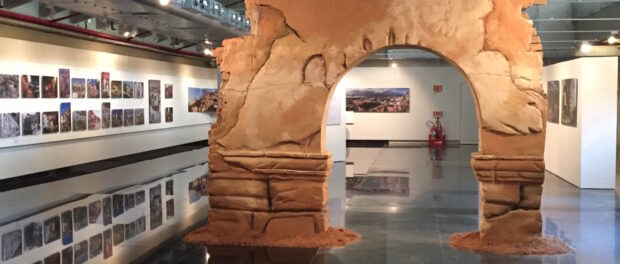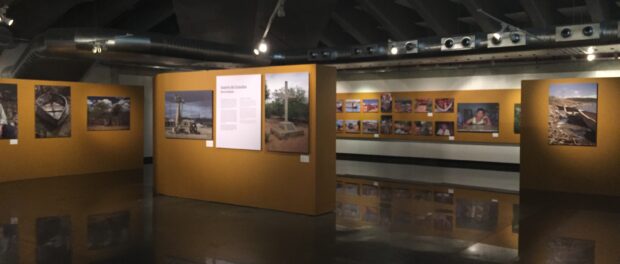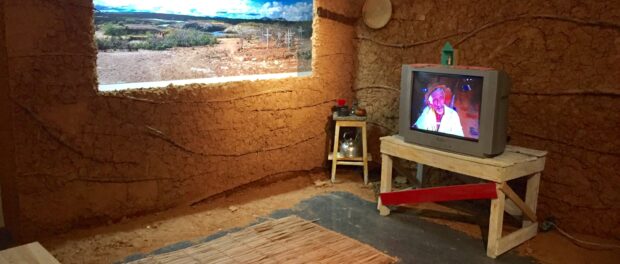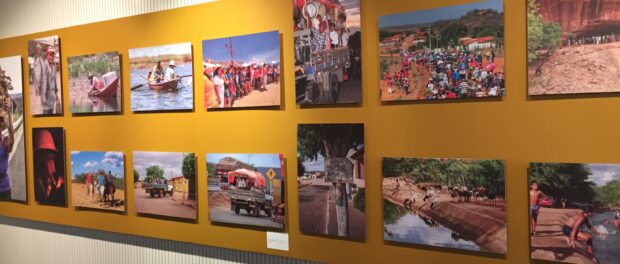
It’s an old story to anyone familiar with Rio’s favelas and their history: the first favela was founded in 1897, when veterans of the Canudos War, most of them former slaves, established a community on a hill overlooking downtown Rio after the government reneged on a promise of land in exchange for fighting. The settlement, initially called “Favela Hill” after a robust plant that grows in the backlands of Brazil’s Northeast, where Canudos is located, is today known as Providência, Rio’s oldest favela, that is marking 120 years since its founding this year. A great deal of history both before and after that founding date, however, remains largely unremembered in Rio and Brazil at large. “Favela Hill, to Providência, from Canudos,” an exhibit by photographer Maurício Hora, on display at the National Development Bank Cultural Space until July 14, seeks to change that perception.
The exhibition was born out of Hora’s travels to Canudos in the state of Bahia in 2013, in an effort to document life in the sertão (arid backlands) and seek out memory of the war “that must not be forgotten”. Hora, a native of Providência, met with residents of the area around Canudos and recorded their stories. One of the most powerful parts of the exhibit are two installations, one meant to represent the interior of a home in Canudos, the other in Providência. Both spaces are centered around television sets playing interviews with residents of both areas.
Juxtapositions and parallels between Canudos and Providência run through the entire exhibit. Water—both its presence and its absence, a crucial difference for residents of the sertão—stands out in the photographs of Canudos, with an image of a wooden boat resting on dry, dusty land located near another of a boat filled with water while floating on a lake. Light also plays a central role in the Canudos photographs, sometimes mercilessly bright and other times sinister and dark, emphasizing the power of the elements over the people, plants, and animals that the images depict.
By contrast, the images of Providência are busier, with the formal city filling the background behind the scenes of the favela. Hora’s photographs of his home focus on daily life, as residents collect water, children play, or a mother braids her daughter’s hair outside their home. Though the photographs from the two areas occupy different sides of the exhibit hall, there is no explicit division between the two parts of the exhibition, emphasizing the historical continuity between the two locales. Occasionally, the photographs’ content links the two sections as well. One image from Canudos depicts a bridge built by confident engineers to last “a thousand years,” only to be submerged by rising water levels almost immediately. In Providência, meanwhile, residents remember a 1967 incident in which a large rock fell from the mountainside and killed multiple people, an event that baffled engineers in Rio, who had predicted that such a thing could never happen.
 Aside from documenting daily life in both locations, the exhibit also brings pieces of history to the forefront, filling in the gaps between 1897 and 2017. The Canudos War took place when Antônio Conselheiros, a charismatic religious leader, began speaking out against the rule of the young Brazilian Republic in the area around Canudos. After three military expeditions failed to dislodge him, the federal government in Rio instructed the leader of the fourth and final army sent to the Northeast “not to leave one stone on top of another in Canudos.” After the destruction of the town and the death of nearly 25,000 inhabitants, the old city itself was flooded and covered by water. Only during periods of drought, in 1994, 2000, and 2013, were some of the original structures uncovered. Hora took advantage of the latest of these to photograph the region as the drought exposed the century-old debris.
Aside from documenting daily life in both locations, the exhibit also brings pieces of history to the forefront, filling in the gaps between 1897 and 2017. The Canudos War took place when Antônio Conselheiros, a charismatic religious leader, began speaking out against the rule of the young Brazilian Republic in the area around Canudos. After three military expeditions failed to dislodge him, the federal government in Rio instructed the leader of the fourth and final army sent to the Northeast “not to leave one stone on top of another in Canudos.” After the destruction of the town and the death of nearly 25,000 inhabitants, the old city itself was flooded and covered by water. Only during periods of drought, in 1994, 2000, and 2013, were some of the original structures uncovered. Hora took advantage of the latest of these to photograph the region as the drought exposed the century-old debris.
In Providência, the first street occupied and built by the veterans and their families was known as Cajueiros Street. The population of the community and other informal settlements like it swelled in the first decade of the twentieth century as the policies of Mayor Pereira Passos left many urban poor without homes. It is unclear when the favela first became known as “Providência Hill,” but by the 1930s city documents were referring to it as such.
This exhibit is not the first time that Hora has turned his camera on his community. A longtime activist and community leader in Providência, Hora has collaborated with Portuguese sculptor Vihls’ installation in Providência and French artist JR on projects like his Women Are Heroes installation and the Yellow House cultural center, also in Providência. Hora has also staged exhibits of his photography in both Brazil and France. He is the director of the NGO Favelarte, and in 2011 released a graphic novel, “Favela Hill,” with artist André Diniz.
“Favela Hill” links the Northeastern sertão and the favelas of Rio, two areas marginalized in contemporary Brazil that share a great deal despite geographical differences. Hora’s exhibit makes an explicit connection between these places, showing that the favela was not an accident, but a manifestation of a Northeastern, Afro-Brazilian culture that had to adapt to difficult circumstances in Rio. On one wall in the exhibit hall hang pictures of a small church that stands in Providência today. In 1901, the wives of Canudos veterans built this structure in order to house a statue of Christ that had supposedly belonged to Antônio Conselheiros. The church became known as the Cruzeiro chapel, even after the cross for which it was named was lost. Accompanying these images, the photographs’ caption challenges the viewer: “And yours? Where is your cross today?”
Exhibition Details
Dates: May 24-July 14, 2017
Monday to Friday, except holidays, from 10am-7pm
Guided visits from Monday to Friday, except holidays, at 12:30pm; Wednesdays and Thursdays at 6:15pm
Location: Espaço Cultural BNDES
Av, Chile, 100 – Centro, Rio de Janeiro
Near Carioca Metro station




